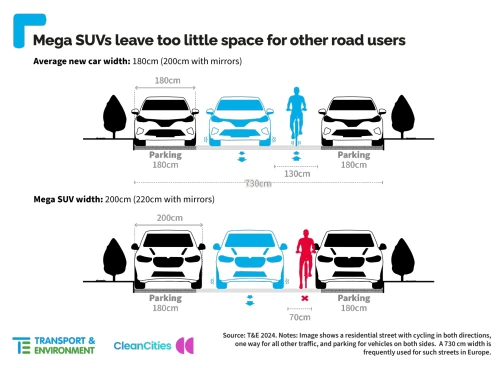New cars in Europe are getting 1 cm wider every two years, on average, according to research by environmental NGO Transport & Environment (T&E). T&E says the trend will continue due to the rising sales of SUVs unless lawmakers take action.
Around half of new cars sold are already too wide for the minimum on-street parking space in many countries. Paris could be the first major European capital to tackle this trend if citizens endorse higher parking charges for SUVs in a referendum next month.
The average width of new cars expanded to 180.3 cm in the first half of 2023, up from 177.8 cm in 2018, the T&E research finds. Data compiled by the ICCT confirms the same trend in the two decades up to 2020. New cars in the EU are subject to the same maximum width—255 cm—as buses and trucks. T&E said that unless the EU width limit for cars is reviewed and cities impose higher parking charges, large SUVs and pick-ups will continue to expand to the cap meant for trucks.

Among the top 100 models in 2023, 52% of vehicles sold were too wide for the minimum specified on-street parking space (180 cm) in major cities, including London, Paris and Rome, the research also finds. Off-street parking is now a tight squeeze even for the average new car (180 cm wide), while large luxury SUVs no longer fit. Measuring around 200 cm wide, large luxury SUVs leave too little space for car occupants to get in and out of vehicles in typical off-street spaces (240 cm).
The growth in size is very pronounced among large luxury SUVs: in the most egregious cases, the Land Rover Defender grew by 20.6 cm and the Mercedes X5 by 6 cm in just six years. In 2023, Volvo went 4.1 cm wider with its EX90. Carmakers are using this growth of the largest SUVs to also increase the width of vehicles in the midsize and compact segments.
The trend towards wider vehicles is reducing the road space available for other vehicles and cyclists while parked cars are further encroaching on footpaths. The wider designs have also enabled the height of vehicles to be further raised, despite crash data showing a 10 cm increase in the height of vehicle fronts carries a 30% higher risk of fatalities in collisions with pedestrians and cyclists.
Several European cities have already introduced more restrictive parking rules for SUVs. The city of Paris is the latest and largest European city to tackle the trend of larger cars and has called citizens to vote on whether parking fees should be tripled for particularly heavy cars.
A recent poll by the Clean Cities Campaign found that around two thirds of Parisians are in favor of higher parking fees for large, heavy and polluting vehicles. If approved, new measures in the French capital would set an important precedent for many other European cities that are considering similar changes.
T&E said EU lawmakers should mandate a review of the maximum width of new cars when they update the legislation in the coming months. Also, city authorities should set parking charges and tolls based on vehicle size and weight, so that large luxury SUVs and pick-ups pay more for using more space.
Source from Green Car Congress
Disclaimer: The information set forth above is provided by greencarcongress.com independently of Chovm.com. Chovm.com makes no representation and warranties as to the quality and reliability of the seller and products.




